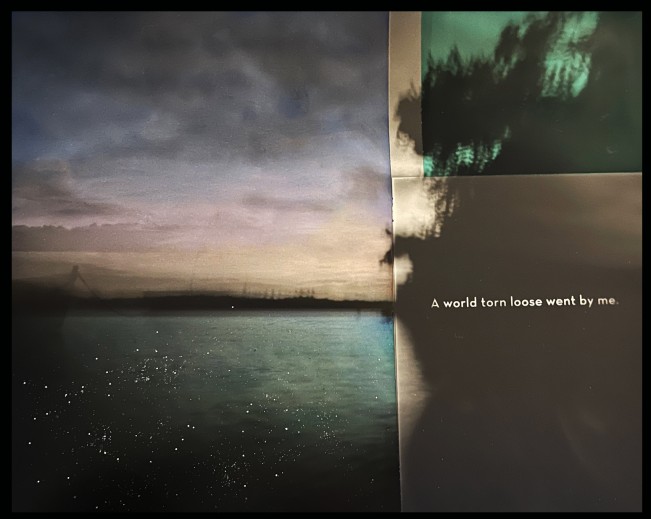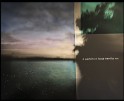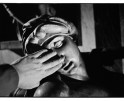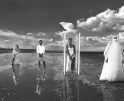2023 in the Rear View Mirror
“Kindness, kindness, kindness. I want to make a New Year’s prayer, not a resolution. I’m praying for courage.”– Susan Sontag
New Years has always been a cocktail filled with equal parts melancholy and malaise, combined with feelings of gratitude and hope for another year. I spent a lot of time on the road this year, stepping away from teaching to experience life and spend more time making art. My husband and I spent two weeks driving across the U.S., rediscovering the joy of the road and learning a lot about this country. I got to see friends on the journey — Samantha Johnston at CPAC in Denver, Sara Silks and Deanna Dikeman in St. Louis, and Crista Dix at the Griffin Museum in Boston. I got meet the wonderful people at the Silver Eye Center of Photography: Leo Hsu, Helen Trompeteler, and Jillian Daniels, then Jessica Johnston and Joan Lyons at the Visual Studies Workshop, and Joshua Farr at the Vermont Center of Photography. I was struck by how open and supportive our community is, and how hard people and organizations work to create opportunities for us all.
I end the year with tremendous gratitude. Thank you to the incredible Lenscratch staff who give so much time and effort to showcasing photographers. Each brings a unique perspective and way of thinking about photography. Our editors in other parts of the world, Michael Honegger in France, Ana Leal in Brazil, Vicente Cayuela in Chile, and Sunjoo Lee in South Korea have all brought us wonderful international artists to learn about. Next year, we have an editor from Turkey and I will be featuring some of the photographers I met at the Tokyo Photo Festival, in addition to more contributions from around the globe.
I want to thank the stellar contributors to Lenscratch this year: Linda Alterwitz, Daniel George, Kellye Eisworth, Kassandra Eller, Emily Wall, Jonas Yip, Clay Lipsky, Ashima Yadava, Michael O. Synder, Sarah Knobel, Sara Bennett, Sara, J. Winston, Barbara Ciurej, Greg Banks, Lindsay Lochman, Tracy L. Chandler, Epiphany Knedler, Megan Bent, Xuan-Hui Ng, Alayna N. Pernell, Donna Garcia, Jake Benzinger, Daniel Hojnacki, Barry Schwartz, Elizabeth Stone, Galina Kurlat, Douglas Breault, Harry Steinway, and Deanna Dikeman.
I look at thousands and thousands of images each year. Jurying portfolios for organizations like Critical Mass, Silver Eye Center of Photography, Blue Sky Gallery, the HeadOn Festival in Australia or the Blow Up Press Book Award in Poland allowed me to see the pulse of work being made with thoughtful intention in 2023. And I have to say, what I am seeing is truly spectacular. The photography world has grown up in the last three years and as storytellers, the power of the projects being created today is profound.
Recently, there has been a lot of conversation about success…and rejection. Sometimes I wonder if we didn’t have social media to announce our successes, would we worry as much about looking for the gold ring, over and over? The pandemic gave me a moment to consider what success means to me (and I encourage you to do the same). I realized that I want to tell my stories and pursue subjects with passion and complexity. I also want to make work for the next generation, in particular my children, and someday, my grandchildren. I want to put my work into forms that will move through time. Success is an internal journey and it has made me step away from Facebook and keep things closer to my chest.
Whether you succeed or not is irrelevant—there is no such thing. Making your unknown known is the important thing. – Georgia O’Keeffe
I have shared the words of artist Teresita Fernández over the years and I’m sharing them with you again today. I hope that you take some of this thinking and move into 2024 filled with joy and happiness.
In those moments when you feel discouraged or lost in the studio, or when you experience rejection, rest completely assured that what you don’t know about something is also a form of knowledge, though much harder to understand. In many ways, making art is like blindly trying to see the shape of what you don’t yet know. Whenever you catch a little a glimpse of that blind spot, of your ignorance, of your vulnerability, of that unknown, don’t be afraid or embarrassed to stare at it. Instead, try to relish in its profound mystery. Art is about taking the risk of engaging in something somewhat ridiculous and irrational simply because you need to get a closer look at it, you simply need to break it open to see what’s inside.
We live in a meritocratic society, where accomplishments are constantly being measured externally, where forms are always read from the outside, where comfort and lifestyle are often mistaken for success, or even happiness. Don’t be fooled. Our ideas regarding success should be our own, and I urge you to pursue it simultaneously from both the inside and the outside. As artists, it will be especially difficult to measure these ideas of what success may be because you have chosen a practice that is entirely dependent on being willing to possibly fail, over and over again regardless of any successes that do come your way.
Success is just another form, with both an inside and outside.
For the most part people are aware of what the outside of success looks like. Outside success always seems to look terribly glamorous, and every once in a while it can be. But it still never means all that much, and it still never makes the work of the work any easier — if anything, it makes it a little harder because the stakes get higher; the possible humble failures become less private and more visible and more cruelly judged.
The day after a successful opening or the completion of a body of work is something I have always likened to a hangover. There is a need to have a big greasy breakfast and get all of people’s celebratory compliments out of your bloodstream.
A kind of panic sets in the very next day, an urge to get into the studio because you know you have to start all over again, building something from nothing, seeking the company of those trusted beneficial failures, waiting for those absurd internal dialogues with your own gang of voices. It’s not a very glamorous scenario. But this is precisely what internal success looks like. It is visible only to yourself and while you can trick the rest of the world into thinking you are a good artist, you can never really convince yourself, which is why you keep trying. If you’re lucky and motivated enough to keep making art, life is quiet, you get to work at what you love doing, happily chipping away at something, constructing something, adjusting to a cycle of highs and lows and in betweens, and it doesn’t matter if you’ve been doing it for two years or 50 years, the patterns remain exactly the same. The anxiety continues to set in, the doubts creep in, the baby steps towards mending fragments starts all over again, the cautious urge to peek between the cracks is there. When you find yourself in that place, that’s when you’ll know that the inside is driving the outside.
That hunger, that desire for success is nothing more than a fear of failure… And the odd thing is that when you are actually succeeding, it tends to be quiet and comes always quite unannounced and without a lot of fanfare. You will, in fact, be the only person who ever really grasps or recognizes the internal successes. The work of the work is visible only to yourself.
Art requires time — there’s a reason it’s called a studio practice. Contrary to popular belief, moving to Bushwick, Brooklyn, this summer does not make you an artist. If in order to do this you have to share a space with five roommates and wait on tables, you will probably not make much art. What worked for me was spending five years building a body of work in a city where it was cheapest for me to live, and that allowed me the precious time and space I needed after grad school.
Learn to write well and get into the habit of systematically applying for every grant you can find. If you don’t get it, keep applying. I lived from grant money for four years when I first graduated.
Nobody reads artist’s statements. Learn to tell an interesting story about your work that people can relate to on a personal level.
Not every project will survive. Purge regularly, destroying is intimately connected to creating. This will save you time.
Edit privately. As much as I believe in stumbling, I also think nobody else needs to watch you do it.
When people say your work is good do two things. First, don’t believe them. Second, ask them, “Why”? If they can convince you of why they think your work is good, accept the compliment. If they can’t convince you (and most people can’t) dismiss it as superficial and recognize that most bad consensus is made by people simply repeating that they “like” something.
Don’t ever feel like you have to give anything up in order to be an artist. I had babies and made art and traveled and still have a million things I’d like to do.
You don’t need a lot of friends or curators or patrons or a huge following, just a few that really believe in you.
Remind yourself to be gracious to everyone, whether they can help you or not. It will draw people to you over and over again and help build trust in professional relationships.
And lastly, when other things in life get tough, when you’re going through family troubles, when you’re heartbroken, when you’re frustrated with money problems, focus on your work. It has saved me through every single difficult thing I have ever had to do, like a scaffolding that goes far beyond any traditional notions of a career.
Being an artist is not just about what happens when you are in the studio. The way you live, the people you choose to love and the way you love them, the way you vote, the words that come out of your mouth, the size of the world you make for yourselves, your ability to influence the things you believe in, your obsessions, your failures — all of these components will also become the raw material for the art you make.
“Above all else, it is about leaving a mark that I existed: I was here. I was hungry. I was defeated. I was happy. I was sad. I was in love. I was afraid. I was hopeful. I had an idea and I had a good purpose and that’s why I made works of art.” – Félix González-Torres
Happy New Year!
We would so appreciate a donation in any amount as you consider your year end giving!
Posts on Lenscratch may not be reproduced without the permission of the Lenscratch staff and the photographer.
Recommended
-
2023 in the Rear View MirrorDecember 31st, 2023
-
The 2023 Lenscratch Staff Favorite ThingsDecember 30th, 2023
-
Inner Vision: Photography by Blind Artists: The Heart of Photography by Douglas McCullohDecember 17th, 2023
-
Black Women Photographers : Community At The CoreNovember 16th, 2023




















































